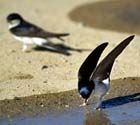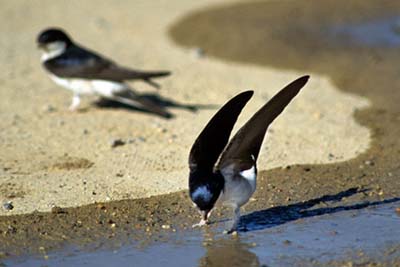The secret lives of house martins
Simon Lester explores the world of that seasonal visitor to Britain, the house martin


House martins have friendly faces. I know this, as the house we've lived in for the past seven years has allowed us a bird's-eye view of these charming creatures and the way they bring up their families. This small bird, with glossy, blue-back upper parts, a tiny black beak and pure-white under parts, is about 5in tall (2in shorter than its cousin, the swallow), with a less pronounced V-shaped tail than a swallow or a swift. However, they are remarkably similar in many ways. All members of the Hirundinidae family feed on insects caught in flight in their gaping beaks, they nest in colonies-returning year after year to the same locations-and they share that same fantastic journey from Britain to sub-Saharan Africa every autumn.
Yet, when compared with the swallow, we know very little about Delichon urbica. Even the BTO says: ‘We have virtually no information on where UK house martins spend the winter and, additionally, we are concerned that the information we have on their breeding populations is incomplete.' Worryingly, these tiny birds, weighing no more than three-quarters of an ounce, that live so close to man-eschewing their natural cave and clifftop nests in favour of sites around houses, bridges and barns-have declined by 15% in the past 10 years. This year, the BTO will catch and fit martins with geolocators to try to discover exactly where in Africa they overwinter and what they do while there.
Like many, I'm delighted by their return, as it means summer isn't far away. Here in south-west Scotland, we usually see our first martins in mid April, just before the swallows arrive but not so this year, as I saw my first swallow on April 14. Frenetic nest building begins within a few days of their reappearance. Often, they use the same nest as before, with only minor repairs required. But here, none of the exquisite mud creations they leave tucked away, high in the window reveals of our exposed cottage, survive the winters, so they start from scratch.

We watch from mere feet away as they swoop from mud patch to building site, like architects and navvies rolled into one. ‘If the weather be fine, the martin begins to think in earnest of providing a mansion for its family,' observed Gilbert White in 1789. ‘The crust or shell of this nest seems to be formed of such dirt and loam as comes most readily to hand, and is tempered and wrought together with little bits of broken straw to render it tough and tenacious.' It can take up to two weeks and 1,000 beakfuls of mud to build each nest and, within days, these armour-plated homes have dried out, ready for the interior decoration of feathers and fine grasses. Once complete, they are closed, save for an entrance hole, unlike the open-cupped swallow's nest.
Soon after, the hen lays four or five white eggs, which she and the male incubate. When they hatch, about 14-16 days later, the bald, pink-skinned chicks need brooding. They grow rapidly on a high-protein diet of flies, beetles and aphids and, soon, mum and dad are frantically whizzing to and from the nest all day, bringing in food and throwing out the chicks' poo sacks-chattering to each other all the while.
On one rare occasion for this over-refreshed part of Scotland, we had a drought in April and the martins returned to marooned tadpoles and dust instead of mud. When it rained, they gathered around any puddles in huge numbers and I'm sure they helped each other out by taking turns to build each other's nests.
At the opposite extreme, a few years ago, it was so wet that some nests collapsed before the chicks were old enough to fledge. Alerted by the adult birds' alarm calls, we found the helpless chicks on the grass, surrounded by the muddy remains of their nest. We improvised by fashioning a nest from a black-plastic mushroom carton, cutting a hole in the front, and fixing it near to where the real nest had been.
Exquisite houses, the beauty of Nature, and how to get the most from your life, straight to your inbox.
The first rescue attempt saw all chicks fledge successfully, but not the second, possibly because the adult birds failed to find our makeshift nest. Even without such disasters, martins seem to be as prone to family squabbles as we are. Sometimes, we hear a lot of screeching and see adult martins literally dragging others away from the nest. Because they all look the same, it's hard to tell who is who. Nevertheless, as they can rear up to three broods in one summer, I wonder whether these fights are caused by teenagers returning to get a free meal when the parents are desperately trying to feed their next brood.
The most spectacular amount of house martins I have ever seen was when I worked as a gamekeeper at Holkham Hall in Norfolk, where the vast Palladian pile's portico and gene- rous eaves provided ideal nesting sites. Surrounded as it is by parkland full of mature trees, and being next to a 35-acre lake, the enviable location also ensures martins an unlimited food supply. Insects on demand allowed thousands of these blue-and-white acrobats to thrive, scribbling soaring and swooping displays of aerial agility high in the sky, almost out of sight, on fine evenings or buzzing and rippling over the surface of the lake as storms closed in.
Marvellous martins
* There are an estimated 510,000 breeding pairs in the UK * Although house martins play second fiddle to swallows in literature, they feature in Shakespeare's Macbeth, when Banquo brings a ‘martlet' nest to the attention of Duncan at Macbeth's castle * The martlet is a heraldic emblem, often associated with the fourth son of a notable family. Sometimes represented with tufts in place of feet-in fact, their legs and feet are covered with white feathers-to signify its inability to land and the younger sibling's landlessness, martlets also stood for swiftness * Old wives' tales include the mistaken belief that house martins would close up nest entrances with a marauding house sparrow inside or gang up to kill sparrows
* Follow Country Life on Twitter
Country Life is unlike any other magazine: the only glossy weekly on the newsstand and the only magazine that has been guest-edited by His Majesty The King not once, but twice. It is a celebration of modern rural life and all its diverse joys and pleasures — that was first published in Queen Victoria's Diamond Jubilee year. Our eclectic mixture of witty and informative content — from the most up-to-date property news and commentary and a coveted glimpse inside some of the UK's best houses and gardens, to gardening, the arts and interior design, written by experts in their field — still cannot be found in print or online, anywhere else.
